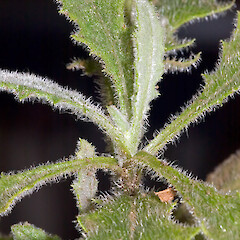Senecio scaberulus
Common name
fireweed
Synonyms
Erechtites scaberulus Hook.f. var. scaberulus, E. scaberulus var. chathamica Allan, Senecio hispidulus var. scaberulus (Hook.f.) Belcher, Senecio hispidulus A.Cunn. nom. illegit.
Family
Asteraceae
Flora category
Vascular – Native
Endemic taxon
Yes
Endemic genus
No
Endemic family
No
Structural class
Herbs - Dicotyledonous composites
NVS code
The National Vegetation Survey (NVS) Databank is a physical archive and electronic databank containing records of over 94,000 vegetation survey plots - including data from over 19,000 permanent plots. NVS maintains a standard set of species code abbreviations that correspond to standard scientific plant names from the Ngä Tipu o Aotearoa - New Zealand Plants database.
SENSCA
Chromosome number
2n = 60
Current conservation status
The conservation status of all known New Zealand vascular plant taxa at the rank of species and below were reassessed in 2017 using the New Zealand Threat Classification System (NZTCS) – more information about this can be found on the NZTCS website. This report includes a statistical summary and brief notes on changes since 2012 and replaces all previous NZTCS lists for vascular plants.
Please note, threat classifications are often suggested by authors when publications fall between NZTCS assessment periods – an interim threat classification status has not been assessed by the NZTCS panel.
- Conservation status of New Zealand indigenous vascular plants, 2017 . 2018. Peter J. de Lange, Jeremy R. Rolfe, John W. Barkla, Shannel P. Courtney, Paul D. Champion, Leon R. Perrie, Sarah M. Beadel, Kerry A. Ford, Ilse Breitwieser, Ines Schönberger, Rowan Hindmarsh-Walls, Peter B. Heenan and Kate Ladley. Department of Conservation. Source: NZTCS and licensed by DOC for reuse under the Creative Commons Attribution 4.0 International licence.
2017 | Threatened – Nationally Critical | Qualifiers: EF
Previous conservation statuses
2012 | Threatened – Nationally Critical | Qualifiers: EF
2009 | Threatened – Nationally Critical | Qualifiers: EF
2004 | Threatened – Nationally Endangered
Distribution
Endemic. New Zealand, North Island from the Three Kings Islands south to Raglan Harbour and the Purua River, north of Thames. S. scaberulus is now mainly seen in eastern Northland and on some of the Hauraki Gulf Islands (Fanal, Ponui and Goat Islands). Also known from Chatham (Rekohu) Island where it was last seen in February 1996. Recorded from the South Island from Picton, Akaroa and Dunedin. All these port records (which include the type gathering) are possibly accidental introductions from the North Island via shipping traffic as this species was once abundant on the Auckland waterfront. Senecio scaberulus has not been reliably recorded from the South Island since the 1860s.
Habitat
Coastal scrub, forest margins and clearings. Shaded sites amongst short grasses, under coastal pohutukawa (Metrosideros excelsa Sol. ex Gaertn.) forest or short scrub, on rock outcrops, cliffs or banks near the sea, often occurring with Senecio hispidulus A.Rich. Also found at inland sites, on bare lava, with forest on bluffs and in canopy gaps.
Detailed description
Grey-green to silvery grey-green, annual or short-lived perennial herb up to 1.5 m tall (usually much less, and depending on local growing conditions). All vegetative parts densely covered in short hairs of both the velutinous and hispid type. Mid cauline leaves 30-200 x 0.5-6 mm, upper surface dark grey-green, covered in distinctly shorter more hispid hairs, undersides pale grey to purple, densely invested in longer, velutinous hairs. Lamina initially sessile becoming shortly petiolate further up stem; lamina narrowly to broadly ovate-elliptic, dentate, pinnately lobed, or pinnatifid, with segments triangular to narrow-oblong, or 1-3-pinnatifid at base. Uppermost leaves similar but smaller, lanceolate, dentate, lobed or sometimes entire. Inflorescences 1-3 per plant, either in sparse or densely flowered corymbs depending on growing conditions, glabrescent. Supplementary bracts 4-8, 1-2 mm long. Involucral bracts 10-13, glabrescent or glabrous, 5-7 mm long. Ray florets absent. Disc sulphur yellow, 2-3 mm diam. Cypsela (seed) 2-3 mm long, subcylindric, slightly constricted below apex, deeply and longitudinally ribbed, surface more or less evenly covered in short hispid hairs.
Similar taxa
Senecio hispidulus A.Rich. is similar but usually larger, and its more heavily divided leaves are covered with short white hairs that have a rasp-like rather than velvety texture when brushed. It also has a more crowded inflorescence and slightly smaller cypsela (seeds) which only have hairs in distinct rows rather than scattered over the seed surface. S. scaberulus might also be confused with S. glomeratus Poiret, but that species is copiously covered in long white, cob-webbed (lanate) hairs.
Flowering
October-February
Flower colours
Yellow
Fruiting
November - April
Propagation technique
Easy from fresh seed. Does best in a free draining semi-shaded site with minimal competition from taller plants. Rather fast growing. However, this is a weedy species which is unlikely to prove popular in cultivation.
Threats
This species is seriously threatened throughout its range. Formerly widespread in open successional habitats, especially the Auckland lava fields, these habitats have either been lost to urbanisation or covered in foreign weed species. Browsing by domestic stock, feral mammals and exotic invertebrate herbivores appears to be a problem in some areas. At all of the known sites the species is still subjected to competition from exotic plants. Hybridization with Senecio hispidulus is also believed to be a serious threat to this species.
Etymology
senecio: From the Latin senex ‘old man’ (probably referring to the bearded seeds)
scaberulus: A little roughened
Attribution
Fact Sheet prepared for the NZPCN by P.J. de Lange 12 July 2005. Description by P.J. de Lange and subsequently published in de Lange et al. (2010).
References and further reading
de Lange, P.J.; Heenan, P.B.; Norton, D.A.; Rolfe, J.R.; Sawyer, J.W.D. 2010: Threatened Plants of New Zealand. Canterbury University Press, Christchurch.
NZPCN Fact Sheet citation
Please cite as: de Lange, P.J. (Year at time of access): Senecio scaberulus Fact Sheet (content continuously updated). New Zealand Plant Conservation Network. https://www.nzpcn.org.nz/flora/species/senecio-scaberulus/ (Date website was queried)






















